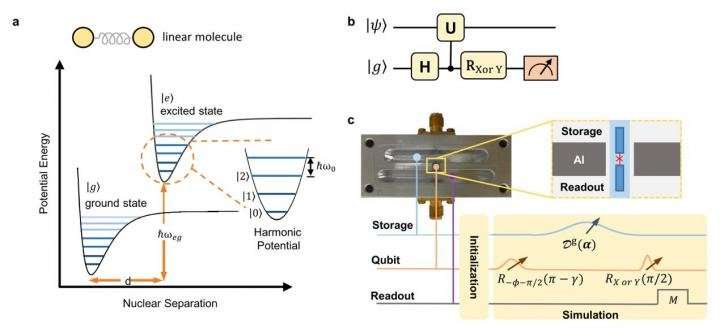Simulating molecular spectroscopy with circuit quantum electrodynamics

Simulation of quantum chemistry is one of the killer applications of quantum computers. In recent years, Google, IBM and other IT companies have been engineering increasingly good superconducting qubits for the purpose of simulating molecular structures. In the beginning, the quantum phase estimation algorithm was considered for obtaining the ground-state energies of molecules. However, the scalability of such a quantum algorithm is too demanding for current quantum technology. An alternative method is the "variational eigensolver," which can be applied to construct a unitary version of the coupled-cluster ansatz, resolving one of the major obstacles in classical quantum chemistry. However, variational eigensolvers can only provide a means to obtain the electronic structure of molecules. For a comparison with the experimental data, quantum computers should be able to predict the spectra of the molecules.
Recently, a team led by Prof. Man-Hong Yung at SUSTech and Prof. Luyan Sun at Tsinghua University has performed a proof-of-principle experimental demonstration on how superconducting devices can simulate the vibronic spectra of molecules. The superconducting simulator is constructed by a three-dimensional circuit quantum electrodynamics (QED) system, in which a transmon qubit is coupled to 3-D cavities. Two quantum states of the qubit play the roles of the electronic ground and excited states of a molecule, and the quantized electromagnetic modes supported by the cavity are employed to model the vibrations of the molecule. The temporal correlation functions can be obtained directly with the superconducting simulator. Moreover, the electronic-vibronic coupling strength, characterized by the Huang-Rhys parameter, can be adjusted for a wide range of values to simulate different molecules.
Furthermore, the simulator can obtain the spectra of both equilibrium and non-equilibrium states, which may go beyond the capacity of classical computers when scaled up. In the future, when these individual simulators are connected, complex chemical reactions may be studied and predicted with these superconducting devices, which points to a direction where "quantum supremacy" can be achieved for practical applications.
More information: Ling Hu et al, Simulation of molecular spectroscopy with circuit quantum electrodynamics, Science Bulletin (2018). DOI: 10.1016/j.scib.2018.02.001
Provided by Science China Press





















